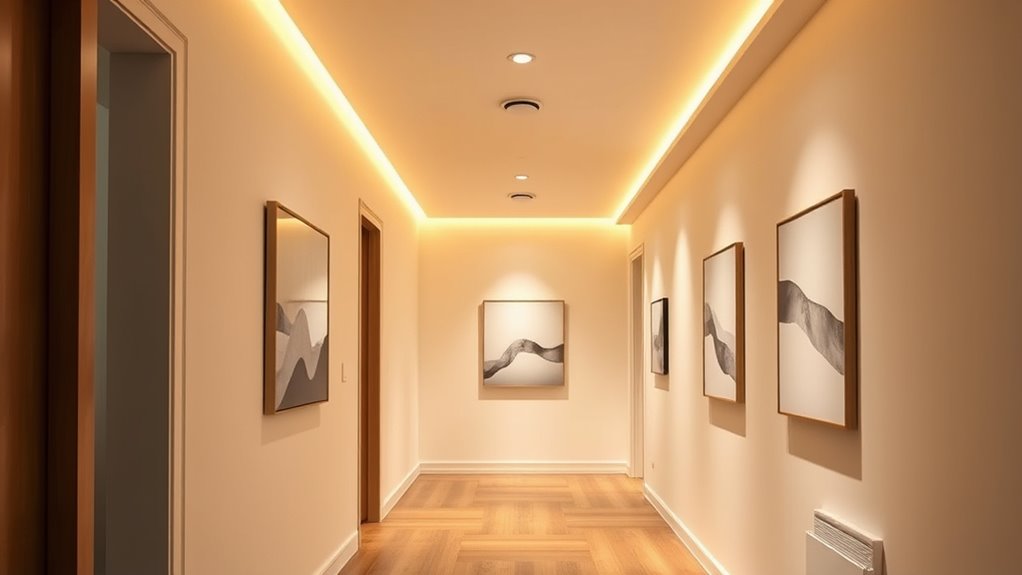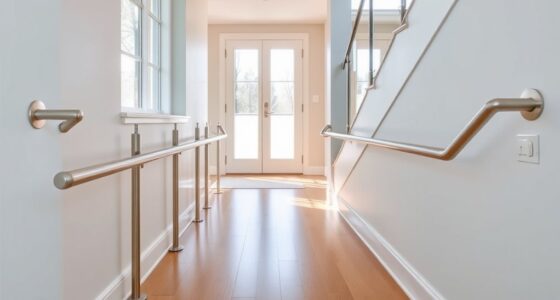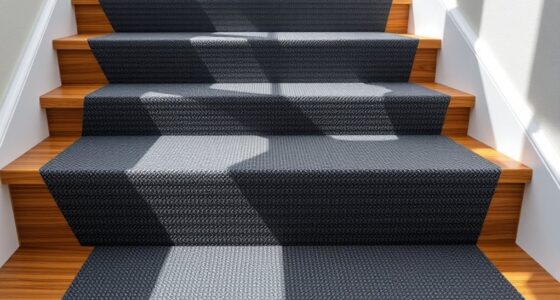To add motion-sensor lights in hallways, position sensors 6 to 8 feet high on walls, facing the space to avoid false triggers from windows or reflections. Adjust sensitivity and delay settings to match hallway activity, and use LED bulbs for better energy efficiency. Proper placement prevents unnecessary activation and extends bulb life. If you keep exploring, you’ll discover tips to optimize energy savings, safety, and smart integrations for your hallway lighting.
Key Takeaways
- Position sensors 6 to 8 feet high on walls, facing hallway to maximize coverage and prevent false triggers.
- Use LED bulbs and adjust sensor sensitivity to optimize energy savings and reduce unnecessary activations.
- Incorporate timers or delay settings to turn off lights after inactivity, enhancing energy efficiency.
- Regularly calibrate and re-position sensors when hallway layout or furniture changes for consistent performance.
- Integrate sensors with smart home systems to schedule lighting and automate functions for convenience and cost savings.

Installing motion sensor lights is a straightforward way to enhance your home’s security and convenience. When it comes to hallways, these lights can automatically illuminate your path, making nighttime navigation safer and more efficient. To maximize their effectiveness, you need to pay attention to light sensor placement. Position the sensors at a height where they can clearly detect movement without triggering false alarms. Typically, placing them around 6 to 8 feet above the ground works well, especially if you’re installing them on walls. Make sure the sensors face a broad area of the hallway to cover the maximum space. Avoid pointing them directly at windows or glass doors, as reflections can interfere with their detection capabilities. Proper light sensor placement ensures that the lights turn on precisely when needed and stay off when not, conserving energy and reducing unnecessary wear on the bulbs.
Energy efficiency tips are essential when installing motion sensor lights in hallways. Choose LED bulbs, which consume less power and last longer than traditional incandescent bulbs. Additionally, consider adjusting the sensitivity settings on your sensors to prevent the lights from activating due to minor movements or passing shadows. This not only conserves energy but also prevents your lights from turning on unnecessarily, which can be distracting or wasteful. Incorporate timers or adjustable delay settings so that the lights turn off after a short period of inactivity. This way, you avoid leaving the lights on longer than necessary, further boosting energy efficiency. If your system allows, set the sensitivity based on the typical activity level in your hallway—less sensitive in quiet hours and more sensitive during busy times. Regularly checking your settings and sensor calibration can ensure optimal performance and energy savings over time.
Another energy-saving tip involves integrating your motion sensor lights with a broader smart home system. You can set schedules or link them to other devices to optimize usage. For example, set the hallway lights to turn off during daylight hours or when you’re away from home. This minimizes waste and ensures your lighting only operates when needed. Regularly check your light sensor placement and settings to make sure they remain ideal, especially if you rearrange furniture or change hallway layouts. Properly positioned sensors and thoughtful adjustments to their sensitivity contribute greatly to the energy efficiency of your lighting system, saving you money while maintaining safety and convenience. Overall, by paying attention to placement and following smart energy tips, you’ll enjoy a well-lit, secure hallway that’s both cost-effective and easy to use.
Frequently Asked Questions
Can Motion-Sensor Lights Be Used Outdoors in Hallways?
Yes, you can use motion-sensor lights outdoors in hallways, but you need to guarantee they’re weatherproofed for outdoor conditions. Consider outdoor weatherproofing to protect against moisture and debris. Also, think about hallway design considerations, like placement and lighting levels, to make sure the sensors work effectively. Properly chosen, weatherproofed motion-sensor lights enhance safety and convenience in outdoor hallways, especially in areas exposed to rain or extreme weather.
What Is the Typical Lifespan of Motion Sensor Bulbs?
Imagine your hallway softly lit by motion sensors, their bulbs glowing steadily. Typically, these bulbs last about 15,000 to 25,000 hours, giving you years of reliable use. This means you’ll enjoy longer intervals between replacements, reducing maintenance. With proper use, your motion sensor bulbs maintain excellent bulb longevity, so you won’t need to worry about frequent replacement. You can count on them to keep your hallways illuminated efficiently for a long time.
Are There Any Safety Concerns Installing Motion Sensors in Hallways?
Yes, there are safety concerns when installing motion sensors in hallways. You might face privacy risks if the sensors are too sensitive or poorly placed, potentially capturing more than intended. False activations can also occur, leading to unnecessary lighting and confusion. To mitigate these issues, guarantee proper placement and sensitivity settings, and inform household members about how the sensors work, keeping safety and privacy in balance.
How Do I Troubleshoot if the Motion Sensor Isn’t Working?
Think of your motion sensor like a detective—if it’s not working, it’s probably missing clues. First, check the sensor sensitivity settings, making sure it’s not set too low. Then, inspect wiring issues—loose or damaged wires can disrupt its function. Reset the sensor if necessary, and test it in different lighting conditions. If it still fails, replace the sensor; sometimes, even detectives need backup.
Do Motion Sensors Consume More Electricity Than Regular Lights?
Motion sensors typically don’t consume more electricity than regular lights because they mainly use a small amount of power for the sensor itself. Your main energy consumption comes from the light bulbs, which are activated when motion is detected. However, if the sensor isn’t accurate or malfunctions, it may run lights unnecessarily, increasing energy use. Ensuring proper sensor placement and calibration helps optimize energy efficiency and maintains accurate sensor operation.
Conclusion
Think of motion-sensor lights as the silent guardians patrolling your hallways, always ready to illuminate your path when needed. Like a lighthouse guiding ships through darkness, they guarantee safety without fuss. By installing them, you create a seamless dance of light and shadow, where every step is met with gentle guidance. Embrace this upgrade as a quiet sentinel, turning your hallway into a well-orchestrated symphony of convenience and security.









